BBS Gene Expression and Its Diversity in the Genus Dendrobium
Abstract
:1. Introduction
2. Materials and Methods
2.1. Biological Materials and Culture Conditions
2.2. RNA Extraction
2.3. Analysis of Gene Expression by Reverse Transcription Quantitative PCR (RT-qPCR)
2.4. Quantitative Analysis of Bibenzyl Using Liquid Chromatography–Mass Spectrometry (LC-MS)
2.5. DNA Extraction and BBS Gene Cloning
2.6. Phylogenetic Analysis of BBS Sequences
2.7. Statistical Analysis
3. Results
3.1. Effects of Mycorrhizal Fungi on Plant Growth
3.2. Effects of Mycorrhizal Fungi on BBS Gene Expression
3.3. Effects of Mycorrhizal Fungi on PAL Gene Expression
3.4. Effects of Mycorrhizal Fungi on Bibenzyl Production
3.5. Phylogenetic Analysis of the BBS Gene in the Genus Dendrobium
4. Discussion
Supplementary Materials
Author Contributions
Funding
Institutional Review Board Statement
Data Availability Statement
Acknowledgments
Conflicts of Interest
References
- Elhamouly, N.A.; Hewedy, O.A.; Zaitoon, A.; Miraples, A.; Elshorbagy, O.T.; Hussien, S.; El-Tahan, A.; Peng, D. The hidden power of secondary metabolites in plant-fungi interactions and sustainable phytoremediation. Front. Plant Sci. 2022, 13, 1044896. [Google Scholar] [CrossRef]
- Vierheiling, H.; Bago, B.; Albrecht, C.; Poulin, M.J.; Piché, Y. Flavonoids and arbuscular-mycorrhizal fungi. Adv. Exp. Med. Biol. 1998, 439, 9–33. [Google Scholar]
- Rasmussen, H.N.; Rasmussen, F.N. Orchid mycorrhiza: Implications of a mycophagous lifestyle. Oikos 2009, 118, 334–345. [Google Scholar] [CrossRef]
- Kovács, A.; Vasas, A.; Hohmann, J. Natural phenanthrenes and their biological activity. Phytochemistry 2008, 69, 1084–1110. [Google Scholar] [CrossRef]
- Zhai, D.; Lv, X.; Chen, J.; Peng, M.; Cai, J. Recent research progress on natural stilbenes in Dendrobium species. Molecules 2022, 27, 7233. [Google Scholar] [CrossRef]
- He, L.; Su, Q.; Bai, L.; Li, M.; Liu, J.; Liu, X.; Zhang, C.; Jiang, Z.; He, J.; Shi, J.; et al. Recent research progress on natural small molecule bibenzyls and its derivatives in Dendrobium species. Eur. J. Med. Chem. 2020, 204, 112530. [Google Scholar] [CrossRef]
- Stoessl, A.; Arditti, J. Orchid phytoalexins. In Orchid Biology. Reviews and Perspectives; Arditti, J., Ed.; Cornell University Press: New York, NY, USA, 1984; Volume 3, pp. 151–175. [Google Scholar]
- Shimura, H.; Matsuura, M.; Takada, N.; Koda, Y. An antifungal compound involved in symbiotic germination of Cypripedium macranthos var. rebunense (Orchidaceae). Phytochemistry 2007, 68, 1442–1447. [Google Scholar]
- Hashimoto, T.; Hasegawa, K.; Yamaguchi, H.; Saito, M.; Ishimoto, S. Structure and synthesis of batatasins, dormancy-inducing substances of yam bulbils. Phytochemistry 1974, 13, 2849–2852. [Google Scholar] [CrossRef]
- Kunz, S.; Becker, H. Bibenzyl derivatives from the liverwort Ricciocarpos natans. Phytochemistry 1994, 36, 675–677. [Google Scholar] [CrossRef]
- Fritzemeier, K.H.; Kindl, H.; Schlösser, E. Two different pathways leading to phenanthrenes and 9,10-dihydrophenanthrenes of the Genus Dioscorea. Z. Naturforsch 1984, 39c, 217–221. [Google Scholar]
- Crombie, L.; Mary, W.; Crombie, L. Dihydrostilbenes of Thailand Cannabis. Tetrahedron Lett. 1978, 19, 4711–4714. [Google Scholar] [CrossRef]
- Fritzemeier, K.H.; Kindl, H. 9,10-Dihydrophenanthrenes as phytoalexins of Orchidaceae. Biosynthetic studies in vitro and in vivo proving the route from L-phenylalanine to dihydro-m-coumaric acid, dihydrostilbene and dihydrophenanthrenes. Eur. J. Biochem. 1983, 133, 545–550. [Google Scholar] [CrossRef]
- Preisig-Müller, R.; Gnau, P.; Kindl, H. The inducible 9, 10-dihydrophenanthrene pathway: Characterization and expression of bibenzyl synthase and S-adenosylhomocysteine hydrolase. Arch. Biochem. Biophys. 1995, 317, 201–207. [Google Scholar] [CrossRef]
- Wang, L.; Albert, N.W.; Zhang, H.; Arathoon, S.; Boase, M.R.; Ngo, H.; Schwinn, K.E.; Davies, K.M.; Lewis, D.H. Temporal and spatial regulation of anthocyanin biosynthesis provide diverse flower colour intensities and patterning in Cymbidium orchid. Planta 2014, 240, 983–1002. [Google Scholar] [CrossRef]
- Boddington, K.F.; Soubeyrand, E.; Van Gelder, K.; Casaretto, J.A.; Perrin, C.; Forrester, T.J.B.; Parry, C.; Al-Abdul-Wahid, M.S.; Jentsch, N.G.; Magolan, J.; et al. Bibenzyl synthesis in Cannabis sativa L. Plant J. 2022, 109, 693–707. [Google Scholar] [CrossRef]
- Chen, Y.; Wang, Y.; Liang, C.; Liu, L.; Song, X.; Zhao, Y.; Wang, J.; Niu, J. Characterization of the key bibenzyl synthase in Dendrobium sinense. Int. J. Mol. Sci. 2022, 23, 6780. [Google Scholar] [CrossRef]
- Schuiteman, A.; Adams, P.B. Dendrobium. In Genera Orchidacearum; Pridgeon, A.M., Cribb, P.J., Chase, M.W., Rasmussen, F.N., Eds.; Oxford University Press: Oxford, UK, 2014; Volume 6, Epidendroideae (Part three); pp. 62–73. [Google Scholar]
- Clements, M.A. Molecular phylogenetic systematics in the Dendrobiinae (Orchidaceae), with emphasis on Dendrobium section Pedilonum. Telopea 2003, 10, 247–298. [Google Scholar] [CrossRef]
- Yukawa, T.; Kurita, S.; Nishida, M.; Hasebe, M. Phylogenetic implications of chloroplast DNA restriction site variation in subtribe Dendrobiinae (Orchidacaeae). Lindleyana 1993, 8, 211–221. [Google Scholar]
- Lawler, L.J. Ethnobotany of the Orchidaceae. In Orchid Biology. Reviews and Perspectives; Arditti, J., Ed.; Cornell University Press: New York, NY, USA, 1984; Volume 3, pp. 27–149. [Google Scholar]
- Zhang, G.Q.; Xu, Q.; Bian, C.; Tsai, W.C.; Yeh, C.M.; Liu, K.W.; Yoshida, K.; Zhang, L.S.; Chang, S.B.; Chen, F.; et al. The Dendrobium catenatum Lindl. genome sequence provides insights into polysaccharide synthase, floral development and adaptive evolution. Sci. Rep. 2016, 6, 19029. [Google Scholar] [CrossRef]
- Yu, Z.; Zhao, C.; Zhang, G.; Teixeira da Silva, J.A.; Duan, J. Genome-wide identification and expression profile of TPS gene family in Dendrobium officinale and the role of DoTPS10 in linalool biosynthesis. Int. J. Mol. Sci. 2020, 30, 5419. [Google Scholar] [CrossRef]
- Si, C.; Teixeira da Silva, J.A.; He, C.; Yu, Z.; Zhao, C.; Wang, H.; Zhang, M.; Duan, J. DoRWA3 from Dendrobium officinale plays an essential role in acetylation of polysaccharides. Int. J. Mol. Sci. 2020, 28, 6250. [Google Scholar] [CrossRef] [PubMed]
- Shan, T.; Zhou, L.; Li, B.; Chen, X.; Guo, S.; Wang, A.; Tian, L.; Liu, J. The plant growth-promoting fungus MF23 (Mycena sp.) increases production of Dendrobium officinale (Orchidaceae) by affecting nitrogen uptake and NH4+ assimilation. Front. Plant Sci. 2021, 12, 693561. [Google Scholar] [CrossRef] [PubMed]
- Adejobi, O.I.; Guan, J.; Yang, L.; Hu, J.M.; Yu, A.; Muraguri, S.; Liu, A. Transcriptomic analyses shed light on critical genes associated with bibenzyl biosynthesis in Dendrobium officinal. Plants 2021, 10, 633. [Google Scholar] [CrossRef] [PubMed]
- Zhang, L.; Rammitsu, K.; Tetsuka, K.; Yukawa, T.; Ogura-Tsujita, Y. Dominant Dendrobium officinale mycorrhizal partners vary among habitats and strongly induce seed germination in vitro. Front. Ecol. Evol. 2022, 10, 994641. [Google Scholar] [CrossRef]
- Liu, L.; Han, R.; Yu, N.; Zhang, W.; Xing, L.; Xie, D.; Peng, D. A method for extracting high-quality total RNA from plant rich in polysaccharides and polyphenols using Dendrobium huoshanense. PLoS ONE 2018, 13, e0196592. [Google Scholar] [CrossRef] [PubMed]
- An, H.; Zhu, Q.; Pei, W.; Fan, J.; Liang, Y.; Cui, Y.; Lv, N.; Wang, W. Whole-transcriptome selection and evaluation of internal reference genes for expression analysis in protocorm development of Dendrobium officinale Kimura et Migo. PLoS ONE 2016, 11, e0163478. [Google Scholar] [CrossRef] [PubMed]
- Takamiya, T.; Wongsawad, P.; Sathapattayanon, A.; Tajima, N.; Suzuki, S.; Kitamura, S.; Shioda, N.; Handa, T.; Kitanaka, S.; Iijima, H.; et al. Molecular phylogenetics and character evolution of morphologically diverse groups, Dendrobium section Dendrobium and allies. AoB Plants 2014, 6, plu045. [Google Scholar] [CrossRef] [PubMed]
- Wang, M.; Yu, W.; Yang, J.; Hou, Z.; Li, C.; Niu, Z.; Zhang, B.; Xue, Q.; Liu, W.; Ding, X. Mitochondrial genome comparison and phylogenetic analysis of Dendrobium (Orchidaceae) based on whole mitogenomes. BMC Plant Biol. 2023, 23, 586. [Google Scholar] [CrossRef] [PubMed]
- Burzacka-Hinz, A.; Dudek, M.; Szlachetko, D.L. Potential use of low-copy nuclear gene Xdh at lower taxonomic levels based on phylogenetic analysis of the nominal section of Dendrobium. Acta Soc. Bot. Pol. 2024, 93, 1–13. [Google Scholar] [CrossRef]
- Wood, H.P. The Dendrobiums. Schettler, R., Ed.; A.R.G. Gantner Verlag Ruggell: Liechtenstein, Germany, 2006. [Google Scholar]
- Kumar, S.; Stecher, G.; Li, M.; Knyaz, C.; Tamura, K. MEGA X: Molecular evolutionary genetics analysis across computing platforms. Mol. Biol. Evol. 2018, 35, 1547–1549. [Google Scholar] [CrossRef]
- Cai, J.; Liu, X.; Vanneste, K.; Proost, S.; Tsai, W.C.; Liu, K.W.; Chen, L.J.; He, Y.; Xu, Q.; Bian, C.; et al. The genome sequence of the orchid Phalaenopsis equestris. Nat. Genet. 2015, 47, 65–72. [Google Scholar] [CrossRef]
- Kozlov, A.M.; Darriba, D.; Flouri, T.; Morel, B.; Stamatakis, A. RAxML-NG: A fast, scalable and user-friendly tool for maximum likelihood phylogenetic inference. Bioinformatics 2019, 35, 4453–4455. [Google Scholar] [CrossRef]
- Edler, D.; Klein, J.; Antonelli, A.; Silvestro, D. raxmlGUI 2.0: A graphical interface and toolkit for phylogenetic analyses using RAxML. Methods Ecol. Evol. 2020, 12, 373–377. [Google Scholar] [CrossRef]
- Darriba, D.; Posada, D.; Kozlov, A.M.; Stamatakis, A.; Morel, B.; Flouri, T. ModelTest-NG: A new and scalable tool for the selection of DNA and protein evolutionary models. Mol. Biol. Evol. 2020, 37, 291–294. [Google Scholar] [CrossRef] [PubMed]
- Zhang, L.; Rammitsu, K.; Kinoshita, A.; Tokuhara, K.; Yukawa, T.; Ogura-Tsujita, Y. Symbiotic culture of three closely related Dendrobium species reveals a growth bottleneck and differences in mycorrhizal specificity at early developmental stages. Diversity 2022, 14, 1119. [Google Scholar] [CrossRef]
- Gehlert, R.; Kindl, H. Induced formation of dihydrophenanthrenes and bibenzyl synthase upon destruction of orchid mycorrhiza. Phytochemistry 1991, 30, 457–460. [Google Scholar] [CrossRef]
- Reinecke, T.; Kindl, H. Inducible enzymes of the 9,10-dihydro-phenanthrene pathway. Sterile orchid plants responding to fungal infection. Mol. Plant-Microbe Interact. 1994, 7, 449–454. [Google Scholar] [CrossRef]
- Chen, J.; Tang, Y.; Kohler, A.; Lebreton, A.; Xing, Y.; Zhou, D.; Li, Y.; Martin, F.M.; Guo, S. Comparative transcriptomics analysis of the symbiotic germination of D. officinale (Orchidaceae) with emphasis on plant cell wall modification and cell wall-degrading enzymes. Front. Plant Sci. 2022, 13, 880600. [Google Scholar] [CrossRef]
- Volpin, H.; Elkind, Y.; Okon, Y.; Kapulnik, Y. A vesicular arbuscular mycorrhizal fungus (Glomus intraradix) induces a defense response in Alfalfa roots. Plant Physiol. 1994, 104, 683–689. [Google Scholar] [CrossRef]
- Volpin, H.; Phillips, D.A.; Okon, Y.; Kapulnik, Y. Suppression of an isoflavonoid phytoalexin defense response in mycorrhizal Alfalfa roots. Plant Physiol. 1995, 108, 1449–1454. [Google Scholar] [CrossRef]
- da Trindade, R.; Almeida, L.; Xavier, L.; Lins, A.L.; Andrade, E.H.; Maia, J.G.; Mello, A.; Setzer, W.N.; Ramos, A.; da Silva, J.K. Arbuscular mycorrhizal fungi colonization promotes changes in the volatile compounds and enzymatic activity of lipoxygenase and phenylalanine ammonia lyase in Piper nigrum L. ‘Bragantina’. Plants 2019, 8, 442. [Google Scholar] [CrossRef] [PubMed]
- Li, Q.; Ding, G.; Li, B.; Guo, S.X. Transcriptome analysis of genes involved in dendrobine biosynthesis in Dendrobium nobile Lindl. infected with mycorrhizal fungus MF23 (Mycena sp.). Sci. Rep. 2017, 7, 316. [Google Scholar] [CrossRef] [PubMed]


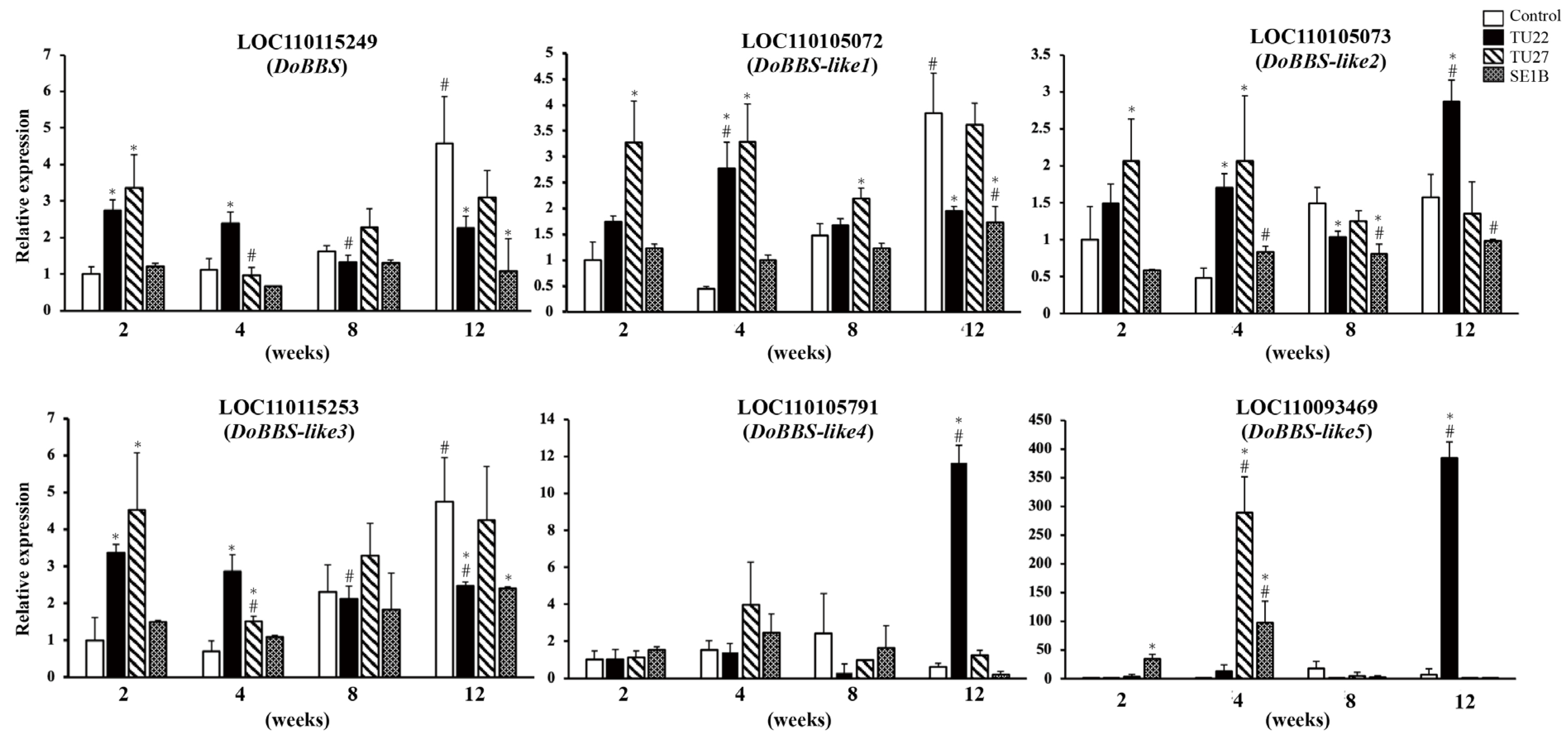
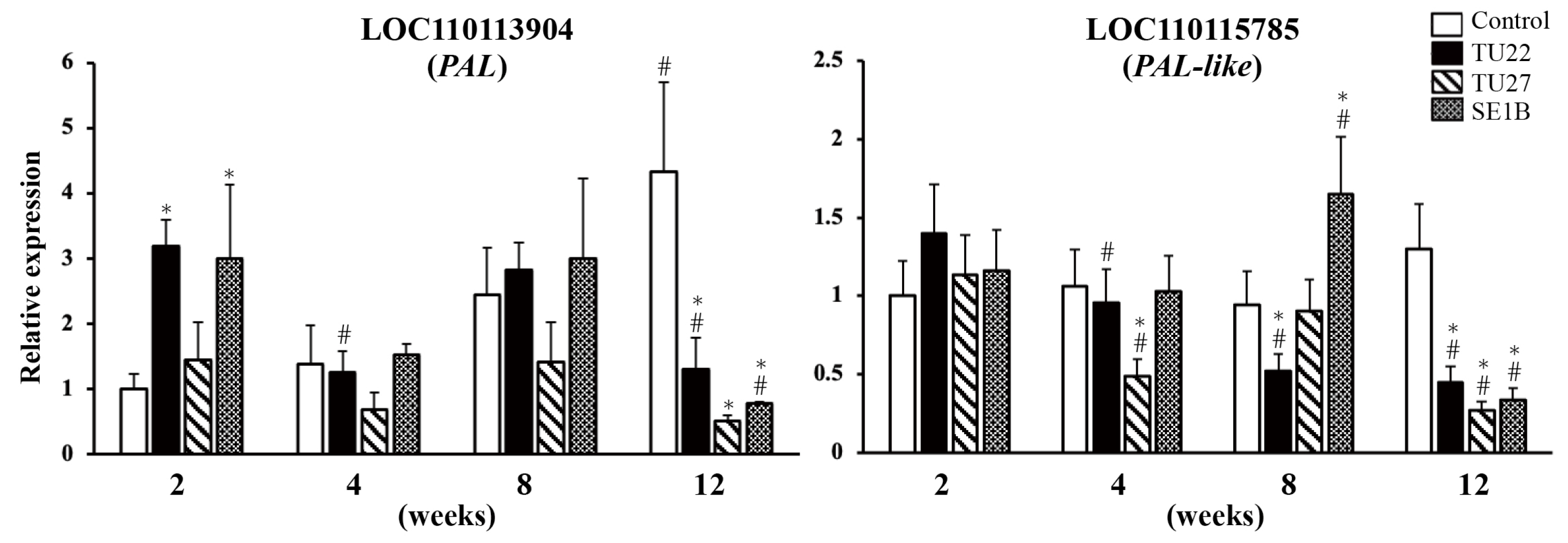
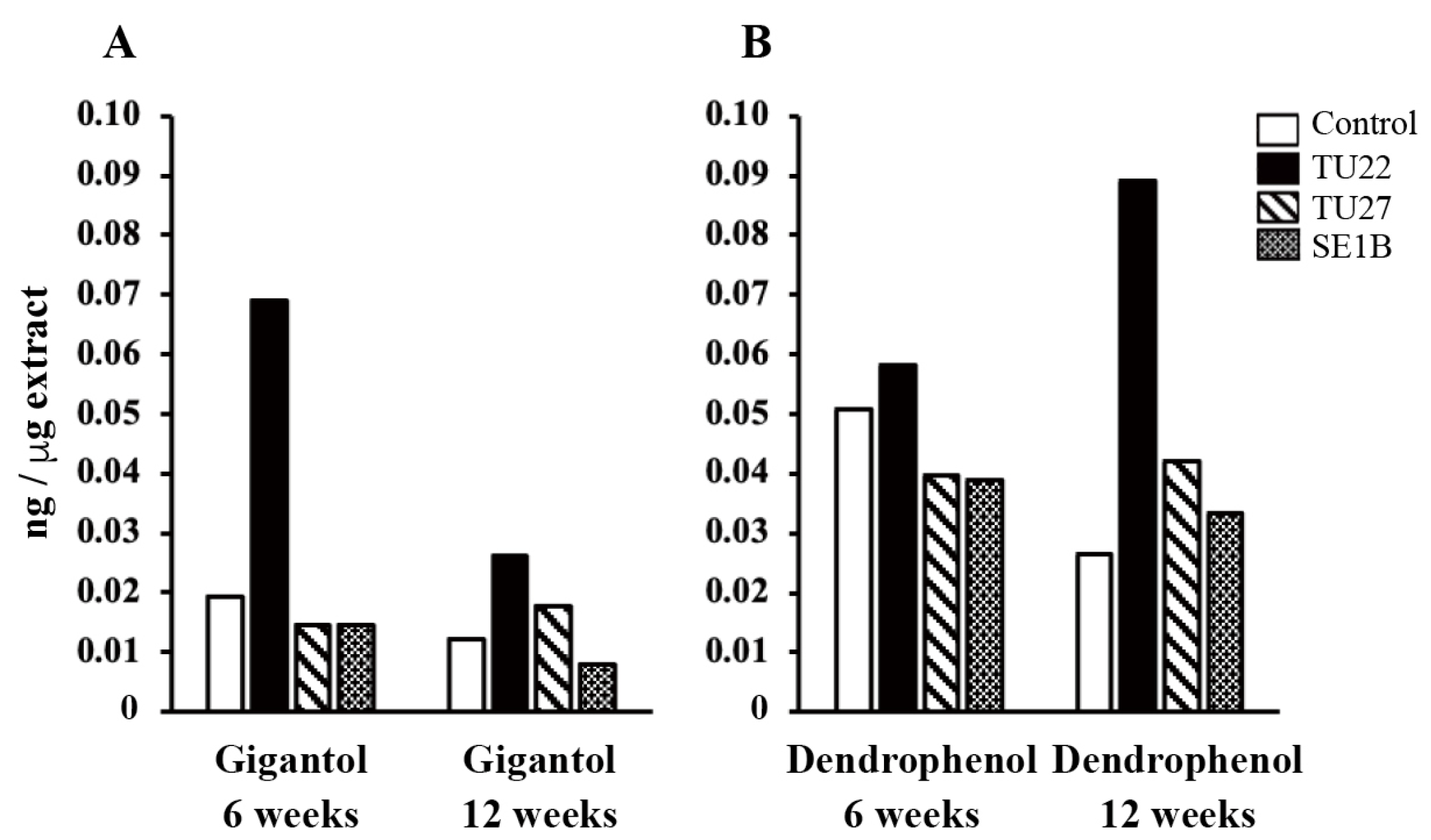
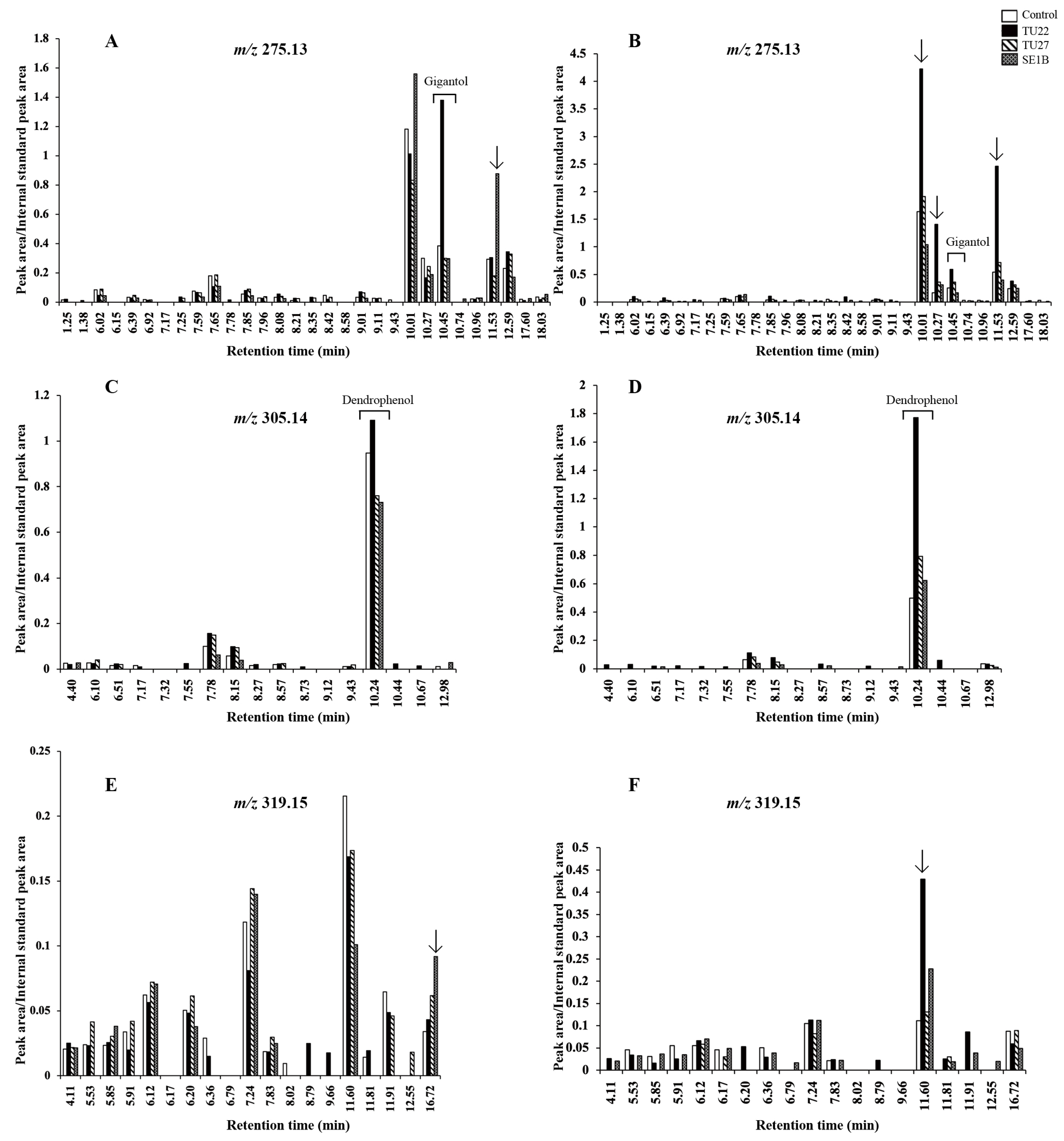
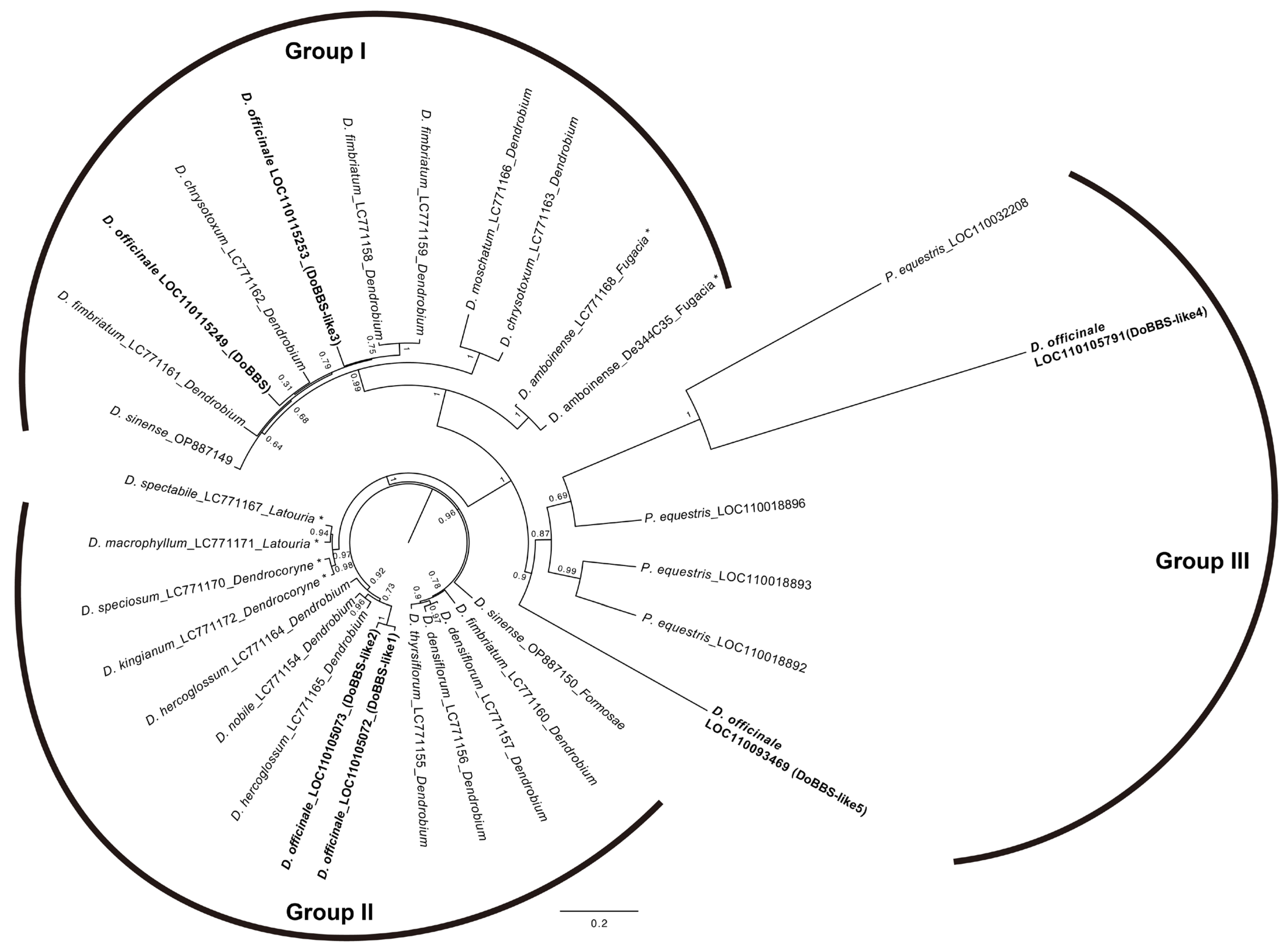
| Gene Symbol | Gene Description | Forward Primer | Reverse Primer | Product Size (bp) | References |
|---|---|---|---|---|---|
| bibenzyl synthase | LOC110115249 | GTTTTTCCGTATCACCAACA | TTATCCATGAAAGTGCTGAA | 150 | Original |
| bibenzyl synthase-like | LOC110105072 | TGAGGAGCACCAAGACGAT | TCCAATAGCACCAGCAGAGT | 163 | Original |
| bibenzyl synthase-like | LOC110105073 | ATTTACCACGAGCAGCTACTG | TTTCTGATGGATTCAAGGCT | 90 | Original |
| bibenzyl synthase-like | LOC110115253 | TTCGTATCACCAAAAGCGA | TTCCATGAATGTGCTGAAG | 143 | Original |
| bibenzyl synthase-like | LOC110105791 | GGATGATTTGATTATCCAAGCT | CTCTGAATTCGGCAGCAAA | 139 | Original |
| bibenzyl synthase-like | LOC110093469 | ATGTTGTTTCGTGGACCAT | CGCTCACCAATAGTCTCGTT | 119 | Original |
| phenylalanine ammonia-lyase | LOC110113904 | TTCAGGAGGCGACACCTACG | GTGATGGTTCCTCTCAGCGGCA | 291 | Original |
| phenylalanine ammonia-lyase-like | LOC110115785 | CAGATTCCTTAATGCAGGAA | GGAGGCAAGGTGTGATATT | 179 | Original |
| actin | LOC110102302 | TGAGCGTGAGATTGTGAGAGAC | GATTCCTGCTGCTTCCATACCA | 211 | An et al., 2016 [29] |
| Clade | Species | Section | Plant ID | Accession Number |
|---|---|---|---|---|
| Asian | Dendrobium hercoglossum Rchb.f. | Dendrobium | De345 | LC771164 LC771165 |
| Asian | Dendrobium nobile Lindl. | Dendrobium | De286 | LC771154 |
| Asian | Dendrobium chrysotoxum Lindl. | Dendrobium | De268 | LC771162 LC771163 |
| Asian | Dendrobium densiflorum Lindl. | Dendrobium | De395 | LC771156 LC771157 |
| Asian | Dendrobium thyrsiflorum B.S.Williams | Dendrobium | De380 | LC771155 |
| Asian | Dendrobium fimbriatum Hook. | Dendrobium | De351 | LC771158 LC771159 LC771160 LC771161 |
| Asian | Dendrobium moschatum (Banks) Sw. | Dendrobium | De209 | LC771166 |
| Australasian | Dendrobium kingianum Bidwill ex Lindl. | Dendrocoryne | De134 | LC771172 |
| Australasian | Dendrobium speciosum Sm. | Dendrocoryne | De343 | LC771170 |
| Australasian | Dendrobium amboinense Hook. | Fugacia | De344 | LC771168 LC771169 |
| Australasian | Dendrobium macrophyllum A.Rich. | Latouria | De451 | LC771171 |
| Australasian | Dendrobium spectabile (Blume) Miq. | Latouria | De324 | LC771167 |
Disclaimer/Publisher’s Note: The statements, opinions and data contained in all publications are solely those of the individual author(s) and contributor(s) and not of MDPI and/or the editor(s). MDPI and/or the editor(s) disclaim responsibility for any injury to people or property resulting from any ideas, methods, instructions or products referred to in the content. |
© 2024 by the authors. Licensee MDPI, Basel, Switzerland. This article is an open access article distributed under the terms and conditions of the Creative Commons Attribution (CC BY) license (https://creativecommons.org/licenses/by/4.0/).
Share and Cite
Takamiya, T.; Saito, M.; Miyamoto, A.; Oikawa, M.; Zhang, L.; Yanagihashi, K.; Okawa, E.; Takahashi, Y.; Suzuki, Y.; Watanabe, M.; et al. BBS Gene Expression and Its Diversity in the Genus Dendrobium. Diversity 2024, 16, 337. https://doi.org/10.3390/d16060337
Takamiya T, Saito M, Miyamoto A, Oikawa M, Zhang L, Yanagihashi K, Okawa E, Takahashi Y, Suzuki Y, Watanabe M, et al. BBS Gene Expression and Its Diversity in the Genus Dendrobium. Diversity. 2024; 16(6):337. https://doi.org/10.3390/d16060337
Chicago/Turabian StyleTakamiya, Tomoko, Manako Saito, Aoi Miyamoto, Mio Oikawa, Liyue Zhang, Kazuki Yanagihashi, Erika Okawa, Yuuka Takahashi, Yui Suzuki, Misaki Watanabe, and et al. 2024. "BBS Gene Expression and Its Diversity in the Genus Dendrobium" Diversity 16, no. 6: 337. https://doi.org/10.3390/d16060337






